by Matt Corrion
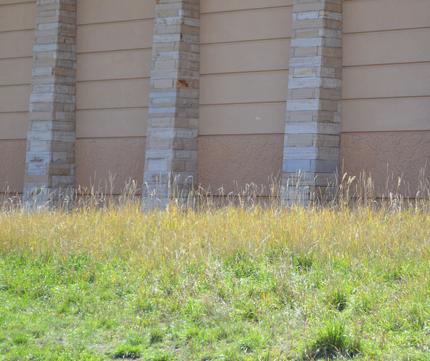
Native grass planting at The Wildlife Experience in Parker, Colorado (designer unknown). Grasses add movement and texture to the landscape. Fall color is not limited to trees and shrubs- there are many different fall colors to be displayed by various types of grasses, from yellows to oranges and reds.
This is the official blog of Outdoor Design Group, Colorado Landscape Architects. For more information about our business and our services, click here.
Related Posts:
by Matt Corrion
Two weeks ago I took a road trip to Phoenix to visit some old friends. We had an amazing time! The desert landscape is so interesting. Since I was visiting in late March, I was not subjected to the 100 degree + temperatures that come in summer, it was a comfortable 80 degrees most of the time.
My friends Brian and Colleen were nice enough to allow me to stay with their family. I brought my camera everywhere, with an eye on photographing and studying the landscape to see what ideas could be incorporated into our landscape designs back home in Colorado. Below I list some of the highlights of places I visited and observed.
Residential Landscapes
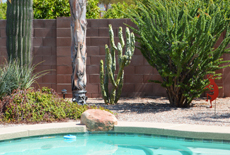
Brian and Colleen’s back yard with “totem pole” cactus – Beautiful!
Saw some interesting things- good and bad… Most homes have no lawn in the front yard, and large back yards typically have a limited amount of lawn. I think this is a good approach that saves water.
So what was used in place of lawn? It seems that at least 50% of the homes have swimming pools, and I saw some very well designed large outdoor patios and outdoor living spaces. For the landscaped areas, the ground cover of choice is small rock mulch (about 3/8″, angular rock).
Within the landscaped areas, I thought some of the plantings were a little thin. Creeping groundcovers, ornamental grasses, and massings of plants could be used more effectively to help cover the rock areas. Other features used in place of lawns were sport courts, outdoor kitchens, and shade structures.
Visiting the Desert Botanical Garden in Phoenix
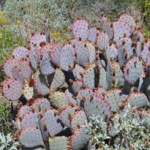
Purple Prickly Pear at the Desert Botanical Garden
This is truly an amazing garden! So many interesting cacti, agave, succulents, and native desert landscaping. They also were featuring some incredible glass sculptures by Dale Chihuly. I highly recommend visiting this garden if you are ever in the area! They have a great Facebook page as well, check it out.
Highway and Roadside Landscaping
One of the more striking features as you drive through Phoenix (and it is a very automobile dependent city) are the large swaths of roadside landscaping along the highways. Most of these areas are highly maintained slopes of rock with a few plants here and there.
My friends told me that there is a constant battle trying to eradicate the weeds from the rock- seems like a silly design solution to me. The nicer areas, in my opinion , had more plants grouped together in random, natural plantings. Other areas had formal planting in patterns and rows, or even just different color rock placed in patterns…

Aerials of Phoenix highway landscaping. Left- one of the nicer designs I saw, with random natural plantings. Right- this section had no plantings, with patterns of colored rock- not a fan of this approach.
Touring Local Nurseries
I had a chance to tour a local suburban Phoenix Nursery. I was interested to see what plants and materials were commercially available. I was happy you see that the trend of edible landscaping was equally as popular in Phoenix as it is in Denver, with a large selection of herbs, fruit trees, and other culinary delights.
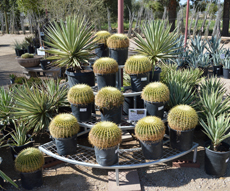
Agave, yucca, and cacti at a local suburban nursery
This nursery also had an impressive collection of sculpture and pottery- These items can add interest to a residential or commercial landscape, require little maintenance, and can serve as interesting focal points to the eye that break up large areas of rock.
One of the more interesting items for sale were packages of two Praying Mantis eggs- for natural pest control.
Hiking in the Superstition Wilderness
On my last day in the Phoenix area, my friend Brian and I went hiking in the Superstition Wilderness area. This turned out to be a very challenging hike to the top of the “flatiron” with amazing views and even more amazing native plants! I couldn’t help but think, – Why couldn’t some of those roadside highway areas be allowed to naturalize like some of this wild landscape, which received no maintenance and no irrigation?
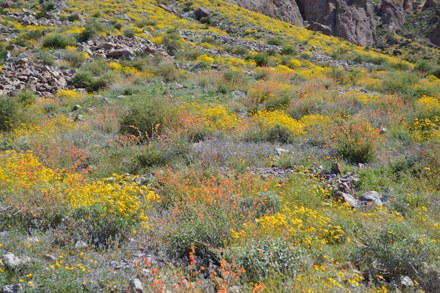
Native wildflowers- the orange flowers are Desert Mallow (Sphaeralcea ambigua), which grows great in my Denver garden!
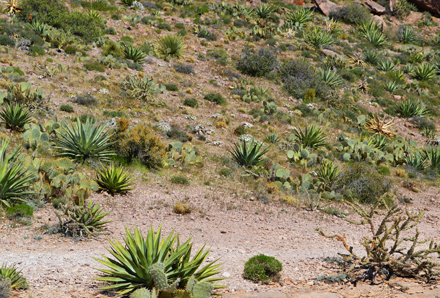
Native landscaping in the Superstition Wilderness area- Why can’t the highway roadside areas be naturalized like this?
This is the official blog of Outdoor Design Group, Colorado Landscape Architects. For more information about our business and our services, click here.
Related Posts:
by Matt Corrion
The Colorado Front Range has some of the best fall weather to be had in the United States. When it comes to interesting fall foliage color however, Colorado lacks the abundance of color that can be found in other parts of the country. But with the right choice of trees you can enjoy some wonderful foliage fireworks in your own backyard.
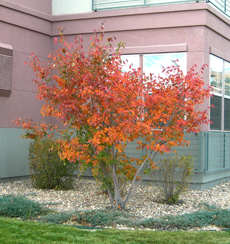 Serviceberry
Serviceberry
Serviceberries are beautiful tree-like shrubs. They offer great spring flowers, edible berries that attract birds and beautiful fall color. They are also good choices for water wise landscapes.
Autumn Brilliance Serviceberry – Amalanchier x grandiflora 12’ Ht x 10’ W
Shadblow Serviceberry – Amalanchier canadensis 12’ Ht x 10’ W
Crabbapple
The popular ornamental trees are renowned for their their spring flowers, but these crabapples provide excellent fall interest as well.
Indian Summer – Malus ‘Indian Summer’ Orange-red fall color. 18’ Ht x 18’ W
Lancelot – Malus ‘Lancelot’ Yellow-gold fall color. 10’ Ht x 8’ W
Prairiefire – Malus ‘Prairiefire’ Orange-red fall color. 20’ Ht x 20’ W
Spring Snow – Malus ‘Spring Snow’ Yellow fall color. 20’ Ht x 20’ W
Ash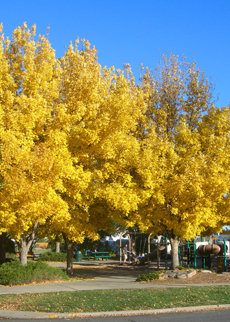
Autumn Purple – Fraxinus Americana As if it glows from within the center of the tree, this Ash is a sight to behold. The color is a mixture of gold to bronze-purple. 50’ Ht x 30’ W
Fall Gold – Fraxinus nigra The bright yellow gold of this tree is great against a crisp blue Colorado fall sky. 40’ Ht x 25’ W
Ornamental Pear
You can find these often planted along streets and in commercial landscapes. They provide spring flowers and fall color in relatively compact form.
Autumn Blaze – Pyrus calleryana ‘Autumn Blaze’ Orange red fall color. 30’ Ht x 25’ W
Chanticleer – Pyrus calleryana ‘Chanticleer’ Orange red fall color in an upright form. 35’ Ht x 15’ W
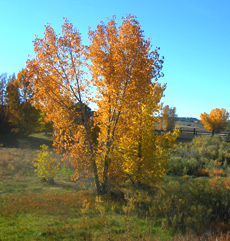 Cottonwood
Cottonwood
Just like their cousin the Aspen, Cottonwoods are known for their yellow gold leaves. Although they are not recommended for residential yards due to their size and tendency to sucker, they are wonderful in large areas with native planting schemes, especially in wetter areas like drainages and ravines.
Plains – Populus sargentii 60’ Ht x 50’ W
Narrowleaf – Populus angustifolia 75’ Ht x 40’ W
Lanceleaf – Populus acuminate 50’ Ht x 30’ W
Maple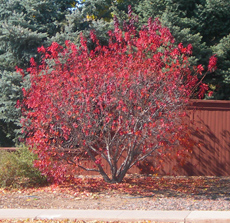
These maple trees will provide great red to orange-red color for your landscape. The Autumn Flame is gorgeous, but it can suffer chlorosis in our alkaline soils. Amur and Tatarian are the most fool-proof choices for our soils and climate.
Amur – Acer ginnala 20’ Ht x 10’ W
Bigtooth – Acer grandidentatum 25’ Ht x 25’ W
Autumn Blaze – Acer x fremanii ‘Autumn Blaze’ 50-40’ Ht x 30-40’ W
Tatarian Maple – Acer tataricum 25’ Ht x 20’ W
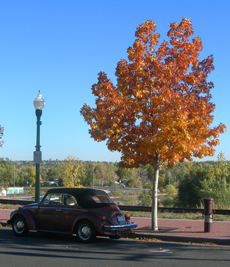 Oak
Oak
Several of the Oak species are wise choices for Colorado Front Range climate and soils. And a few of these offer nice fall foliage as well.
Chinkapin Oak – Quercus muehlenbergii Yellow fall color. 35-50’ Ht x 35-50’ W
English Oak – Quercus robur Golden yellow fall color. 40-60’ Ht x 30-40’ W
Northern Red Oak – Quercus rubra Bronze to wine red fall color. 40-60’ Ht x 40-60’ W
This is the official blog of Outdoor Design Group, Colorado Landscape Architects. For more information about our business and our services, click here.
Related Posts:
by Matt Corrion
Some interesting trends have emerged this year in landscape design. In this article I describe the 5 hottest trends we are seeing – Which of these ideas will you incorporate into your landscape?
Outdoor Stone Fireplaces
Outdoor fireplaces have been around for a long time, but in the last few years they have really gained in popularity. They can serve as a focal point in the design of a backyard landscape, while providing the functional warmth of a fire adjacent to an outdoor patio.
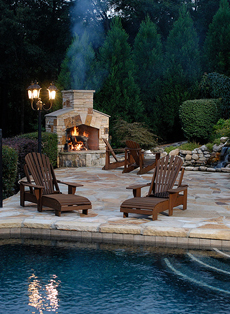 Here in Colorado, where the summers are dry and there are few mosquitoes or other insects, cool summer and fall evenings are perfect for gathering outdoors with family and friends. Outdoor stone fireplaces can add to the ambiance of your outdoor space.
Here in Colorado, where the summers are dry and there are few mosquitoes or other insects, cool summer and fall evenings are perfect for gathering outdoors with family and friends. Outdoor stone fireplaces can add to the ambiance of your outdoor space.
Design Considerations: Outdoor outdoor fireplaces are typically gas burning, unless the property is in a rural area with low fire danger where wood burning is allowed. They can either be custom built using a combination stone, masonry, brick, stucco, or stone veneer; or they can purchased as a prefabricated insert that is put in place and then faced with stone or another decorative material. A combination of decorative stone or concrete caps, mantels, and hearths can also be incorporated, resulting in an almost endless variety of design opportunities.
Due to the increased popularity of outdoor fireplaces and firepits, many municipalities are updating codes and ordinances to provide more specific restrictions and design guidelines. The required distance between the fireplace and any structure may vary between 15 to 25 feet. Always make sure your landscape architect or contractor has checked with your local building department on the current rules and regulations.
Pondless Water Features
Water is one of the building blocks of life. Water features can add a calming effect to your landscape through the sounds and movement of water. They can also mask unwanted noise and bring a peaceful calm to the hustle and bustle of urban living.
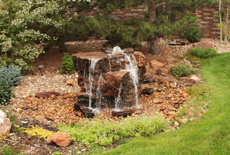 The problem with most water features is that they are high maintenance. While a natural looking pond can be beautiful, they are difficult to construct and can require quite a bit of maintenance. If that maintenance is neglected, or the pond is not constructed correctly one is left with pond that leaks, one does not look natural, or lacks the proper balance of plants, fish, and filters to keep the water clean.
The problem with most water features is that they are high maintenance. While a natural looking pond can be beautiful, they are difficult to construct and can require quite a bit of maintenance. If that maintenance is neglected, or the pond is not constructed correctly one is left with pond that leaks, one does not look natural, or lacks the proper balance of plants, fish, and filters to keep the water clean.
“Pondless” water features solve most of these issues, and are the hottest trend in water feature design. In a pondless water feature, and underground basin in purchased and installed below the ground to hold the water that is circulated through the feature.
A grate is often placed over the basin, and covered with rocks to allow the water to run through to the basin below. The water is pumped from the basin over a decorative rock or sculptural feature. The sound of water is achieved not only from the above ground feature, but by the water splashing through the rocks and into the basin below. And because the basin below ground is shaded from the sunlight, algae will not grow in the water.
Design Considerations: Depending on the size of the feature and how often you intend to run it, you may opt to install a filter and an auto-fill valve connected to a water supply to keep the feature full. You may also opt for an on/off switch for the feature at the home so you can easily turn it on or off. Don’t forget to plan for lighting the feature at night. And finally, when selecting a pump always error on the side of a larger pump, because the flow of water can always be dialed back but can never be increased.
Natural Lawns
As water prices continue to rise, homeowners and businesses are looking for alternatives to the traditional bluegrass lawn. As I have written about in the past, there are many advantages to making your landscaping more efficient, and reducing the amount of bluegrass lawn is the best way to do that.
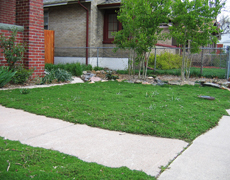 There are many types of plantings that can be used to replace a traditional lawn, but in each case the general principles are the same: plants with reduced watering requirements that require less maintenance. This can we achieved with alternative turfgrasses, Xeriscape plantings, edible garden plants, monocultures of spreading shrubs or perennials, native plants, non-natives, natural meadows, or a combination of these elements.
There are many types of plantings that can be used to replace a traditional lawn, but in each case the general principles are the same: plants with reduced watering requirements that require less maintenance. This can we achieved with alternative turfgrasses, Xeriscape plantings, edible garden plants, monocultures of spreading shrubs or perennials, native plants, non-natives, natural meadows, or a combination of these elements.
Another driver in the popularity of the “natural lawn” concept is the desire of individuals and organizations to move away from using pesticides, herbicides, and fertilizers in large quantities- for the benefit of the environment and human health. Children often play on lawns and in our parks. So in addition to replacing traditional lawns, some people are turning to more organic and natural methods of lawn care.
Design Considerations: It is important to realize that less maintenance does not necessarily mean easier maintenance (at least initially). What I mean by that is a more complex planting such as a Xeriscape with many types of plants, or a natural meadow, will take more analysis and careful monitoring than a simple lawn. However, this monitoring and analysis will be more than made up for by the savings in time and resources by avoiding all of that mowing, edging, aerating, fertilizing, etc. that a traditional lawn would require.
Covered Outdoor Patios
Covered outdoor patios work great for blending indoor and outdoor living space. Over the last decade outdoor patios and gardens have been increasingly utilized as an extension of indoor space.
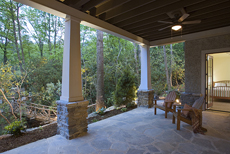 The latest trend is to build a waterproof roof structure over the top of an outdoor patio space. The roof structure is multi-functional, providing shade from the hot afternoon sun as well as protection from the rain and snow. Overhead roof structures also create a more intimate feeling space, creating an outdoor room at a much lower cost than adding a fully enclosed indoor room to a dwelling.
The latest trend is to build a waterproof roof structure over the top of an outdoor patio space. The roof structure is multi-functional, providing shade from the hot afternoon sun as well as protection from the rain and snow. Overhead roof structures also create a more intimate feeling space, creating an outdoor room at a much lower cost than adding a fully enclosed indoor room to a dwelling.
Another benefit to a covered outdoor patio is that outdoor amenities can be protected by the weather. Flat screen televisions, ceiling fans, outdoor kitchens, bar areas, speakers, and lighting can all be incorporated into this outdoor space.
Design Considerations: There are numerous design decisions that need to be made when designing a covered outdoor patio. Will the cover be attached to the home, or free-standing? Support columns for the roof structure can be designed with stone bases. The “ceiling” of the enclosure is also an important design element that should be carefully considered as it will probably be the main surface that you will see when using the space.
Urban Gardening
As the farming industry continues to get more commercialized and corporate, there has been a pushback in the form an increased demand for local farmers markets. And there is no place more local than one’s own yard.
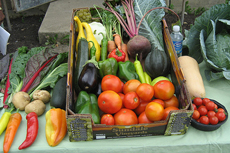 As individuals strive to have more control and knowledge of where their food comes from and how it is grown, many are turning to growing their own produce. Growing a garden is nothing new- however today’s gardens are getting larger and taking up a bigger percentage of the yard. In some cases, urban gardening is being used for an entire backyard or a good portion of a front yard.
As individuals strive to have more control and knowledge of where their food comes from and how it is grown, many are turning to growing their own produce. Growing a garden is nothing new- however today’s gardens are getting larger and taking up a bigger percentage of the yard. In some cases, urban gardening is being used for an entire backyard or a good portion of a front yard.
The urban gardening trend jives perfectly with the “natural lawn” trend. While some people are replacing their traditional lawn with decorative Xeriscapes, others are replacing their lawns with edible gardens. But even edible gardens can be beautiful- there are many decorative herbs that get showy flowers, and some produce such as bright red and yellow peppers can add visual interest to the landscape.
Design Considerations: If you are considering expanding or adding edible garden space there are a few aspects to be mindful of. If you have a homeowner’s association, remember to check their rules on gardens. Consider using decorative paths between your beds, and attractive raised planters can be utilized to keep the space looking a little more organized. Finally, be mindful of pests and rodents that may be attracted to the garden.
This is the official blog of Outdoor Design Group, Colorado Landscape Architects. For more information about our business and our services, click here.
Related Posts:
by Matt Corrion
By now most people in the western U.S. are familiar enough with Xeriscape to know that there is indeed no “zero” in the pronunciation (it’s pronounced more like zeer-escape). The term 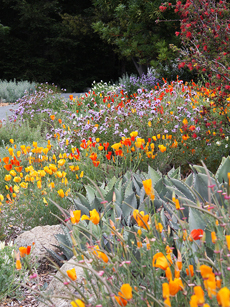 was coined by the Denver Water Department in 1981, are derived from the Greek word “xeros”, meaning dry.
was coined by the Denver Water Department in 1981, are derived from the Greek word “xeros”, meaning dry.
There are 7 principles that make up the concept of Xeriscape: planning and design, improving the soil, creating practical turf areas, irrigating efficiently, proper plant selection, using mulch, and maintaining the landscape.
While I am not sure EXACTLY when the 7 principles were first released (my guess is a few years after the term Xeriscape was first used), I have often wondered whether an update was needed, or if the same 7 principles would be adopted exactly the same today.
While today Xeriscape remains as relevant as ever, there are some important observations I have made through experience regarding the 7 principles, common misconceptions about them, and how they relate to landscaping in today’s rapidly changing world. Therefore, I thought it might be helpful to revisit and add updates to the original 7 principles:
Principle #1: Planning & Design
Updates: Planning and design is as important today as ever. Landscapes continue to get more complex as dozens of new plant choices are introduced each year, along with advances in irrigation systems and controllers. The more complex a project gets, the more benefit is gained from careful planning and design.
Another important development has been the landscape architecture license act of 2007, when Colorado joined the rest of the country in requiring that landscape architects be licensed, and that all commercial and large residential projects (greater than 4 units) have landscape plans that have been prepared by a licensed landscape architect. While this may have raised the cost of design somewhat, a good efficient design will always pay for itself by minimizing surprises during construction, allowing plans to be competitively bid, and lowering maintenance costs over time.
Misconceptions: Xeriscape can only be done in one style. A design will make the project cost more.
Principle #2: Soil Improvements
Updates: This is one area that needs to be looked at closer. The intention of this principle should be to “analyze and improve soil when needed, depending on what plantings are proposed”. The problem has been that many cities and municipalities started to require that all landscaped areas have large amounts of amendment incorporated into the soil over the entire landscaped area, and even requiring dump tickets from the contractors to prove that the amendments were placed.
While this is a good idea for bluegrass and for some types of plants, there are many other plants were the amendment is detrimental to plant health. Many of the very xeric and native plants prefer the native, rockier soil, and can suffer from root rot if soil is heavily amended with organics. I personally think that the amendment should only be tilled into new bluegrass areas, and in the individual planting backfill of those plants that will benefit from it.
Misconceptions: All plants require soil improvements.
Principle #3: Practical Turf Areas
Updates: I am not sure whether the original principle read “Practical Turf Areas” or “Practical Bluegrass Sod Areas”. One of the trends I am seeing that we are starting to use in our designs is the creation of “turf” areas from groundcovers and/or spreading perennials and shrubs. The questions that one needs to ask is not only where will the lawn areas be, but does an area really need to be a “lawn” at all?
Many of the bluegrass turf alternatives are very difficult and sometimes expensive to get established. If an area of the landscape will not be used for games and high foot traffic, then why substitute a hard-to-grow lawn alternative for bluegrass when there are many good spreading plants that are easy to grow? In other words, if a “turf” area will not be used, it simply becomes a low growing visual element, in which case many planting alternatives should be explored.
Misconceptions: Xeriscape means no grass, and bluegrass turf cannot be used in a Xeriscape.
Principle #4: Efficient Irrigation
Updates: Many advancements in irrigation have been made in the past several years, making it possible to irrigate even more efficiently. However, many of these benefits have been over-hyped. While I am all for making our irrigation systems more efficient, this approach does not address the underlying issue- how much water does my landscape REQUIRE to remain healthy? Only by installing water efficient landscapes will any major impact be made.
Misconceptions: If one installs new irrigation heads and a smart controller, the amount of water they will need to use will go down significantly.
Principle #5: Proper Plant Selection
Updates: This principle goes hand-in-hand with a good design. One of the overlooked aspects of this principle is a phenomenon known as “micro-climates”. Microclimates are small climate differences that occur in the landscape due to sun vs. shade relationships, water availability and retention, wind, soil differences, etc. Every day in this business I am reminded how plant selection is impacted by these micro-climates.
One area of debate is the natives vs. non-natives argument. I am firmly in the non-natives camp. There are some amazing native plants that I love to use, but there are also many non-natives discovered every year that meet the needs of our varying miro-climates.
Misconceptions: Only native plants are appropriate to use.
Principle #6: Mulching
Updates: The biggest problem I see with this principle is that all mulches are not created equal. There are cost, aesthetic, and weight differences between wood mulch and rock mulch. Not all plants like being heavily mulched, and some prefer rock mulch over wood mulch, for many of the same reasons some plants do not like a lot of soil amendment. As a result, wood mulch seems to be getting a bad name for Xeriscapes. I have even seen some cities write into code that wood mulch cannot be used for a low water-use zone. But wood is often quite a bit less expensive than rock mulch, and is WAY easier to move around, plant in, and make adjustment to than rock.
The bottom line on mulching- there are different rules to follow based on the type of mulch you are using. If you use wood mulch, use a thin layer and be sure not to over-water. If you use rock, remember that it will be difficult to add plants later or make changes to rocked areas. Also, keep in mid the aesthetics- I feel that too much rock can make a landscape seem a little too harsh, and but having a combination of mulch types can help to visually break up large areas.
Misconceptions: All mulch is the same, all plants love being mulched.
Principle #7: Maintenance
Updates: This is the most undervalued principle. For every 10 beautiful landscapes that I have designed and enjoy visiting time and again, there is at least one commercial landscape where even the most basic maintenance has been neglected. Shrubs have been sheared off into little balls right before they were about to flower, weeds have overtaken a bed area, plants have been over-watered to death.
The biggest piece of advice I can give to property owners or managers is this: walk your landscape once in a while, and make maintenance adjustments based on what you see. Remember that plants are living things, and your job is to understand what will allow each plant to flourish naturally, with the least amount of interference (such as over-watering, over-pruning, etc.) while at the same time minimizing negative factors such as pests, weeds, etc.
Misconceptions: All plants like more water, all shrubs need to be pruned, all plants have similar needs.
This is the official blog of Outdoor Design Group, Colorado Landscape Architects. For more information about our business and our services, click here.
Related Posts:







 Serviceberry
Serviceberry
 Cottonwood
Cottonwood
 Oak
Oak
 The problem with most water features is that they are high maintenance. While a natural looking pond can be beautiful, they are difficult to construct and can require quite a bit of maintenance. If that maintenance is neglected, or the pond is not constructed correctly one is left with pond that leaks, one does not look natural, or lacks the proper balance of plants, fish, and filters to keep the water clean.
The problem with most water features is that they are high maintenance. While a natural looking pond can be beautiful, they are difficult to construct and can require quite a bit of maintenance. If that maintenance is neglected, or the pond is not constructed correctly one is left with pond that leaks, one does not look natural, or lacks the proper balance of plants, fish, and filters to keep the water clean.


 was coined by the Denver Water Department in 1981, are derived from the Greek word “xeros”, meaning dry.
was coined by the Denver Water Department in 1981, are derived from the Greek word “xeros”, meaning dry.